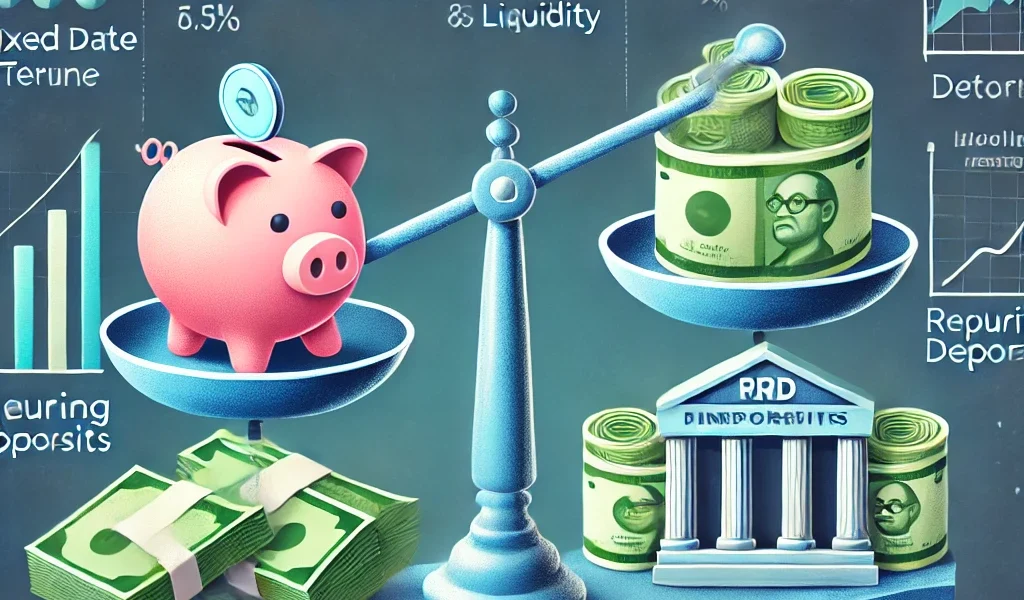Introduction
Saving money is an essential step toward financial security, and choosing the right savings instrument can make a significant difference in your wealth-building journey. Fixed Deposits (FDs) and Recurring Deposits (RDs) are two of the most popular saving options for risk-averse investors. Both provide stable returns, but they serve different financial needs and goals.
In this blog, we will explore the key differences between Fixed Deposits and Recurring Deposits, compare their features, benefits, drawbacks, and help you decide which is the better saving plan for you in 2025.
Understanding Fixed Deposits (FDs)
A Fixed Deposit (FD) is a type of investment where you deposit a lump sum amount in a bank or financial institution for a fixed period at a predetermined interest rate. The principal amount and interest earned are returned to you at the end of the tenure.
Features of Fixed Deposits
- One-time lump sum deposit
- Fixed tenure ranging from 7 days to 10 years
- Fixed interest rates (varies from 5% to 8% per annum)
- Premature withdrawal allowed with a penalty
- Option to receive interest payouts at regular intervals (monthly, quarterly, or annually)
Pros of Fixed Deposits
✅ Guaranteed Returns: Since FD rates are fixed, you get a predictable return on your investment. ✅ Low Risk: FDs are not affected by market fluctuations, making them a safe investment option. ✅ Flexible Tenure: You can choose the tenure based on your financial goals. ✅ Loan Facility: You can avail loans against your FD at lower interest rates. ✅ Senior Citizen Benefits: Higher interest rates are offered for senior citizens.
Cons of Fixed Deposits
❌ Lock-in Period: The money is locked in for the chosen tenure, restricting liquidity. ❌ Inflation Risk: FD returns may not always beat inflation. ❌ Taxable Interest: Interest earned on FDs is taxable under “Income from Other Sources.”
Understanding Recurring Deposits (RDs)
A Recurring Deposit (RD) is a saving scheme where you deposit a fixed amount every month for a predetermined tenure, earning interest at a fixed rate. It is ideal for those who want to save regularly and build a corpus over time.
Features of Recurring Deposits
- Regular monthly deposits
- Fixed tenure ranging from 6 months to 10 years
- Interest rates similar to FDs (between 5% and 7.5% per annum)
- Lump sum payout at the end of the tenure
- No premature withdrawal allowed (except under special conditions)
Pros of Recurring Deposits
✅ Encourages Financial Discipline: Helps in building a habit of saving regularly. ✅ Affordable Investment: Suitable for those who cannot invest a lump sum amount at once. ✅ Fixed Returns: Like FDs, RDs also provide guaranteed returns. ✅ No Market Risks: RDs are not subject to market fluctuations, making them safe. ✅ Loan Facility: Loans can be availed against RD balances.
Cons of Recurring Deposits
❌ Lower Returns Compared to FDs: Since deposits are made monthly, the effective return is slightly lower. ❌ Penalty for Missed Payments: Missing monthly deposits may attract penalties. ❌ No Liquidity: Premature withdrawal is not allowed unless in exceptional cases.
Key Differences: Fixed Deposit vs. Recurring Deposit
| Feature | Fixed Deposit (FD) | Recurring Deposit (RD) |
|---|---|---|
| Deposit Type | Lump sum | Monthly Installments |
| Interest Rate | 5% – 8% | 5% – 7.5% |
| Tenure | 7 days to 10 years | 6 months to 10 years |
| Returns | Higher due to lump sum deposit | Slightly lower due to monthly deposits |
| Liquidity | Premature withdrawal allowed (with penalty) | Limited liquidity, early withdrawal not permitted easily |
| Risk Factor | No risk, fixed returns | No risk, fixed returns |
| Loan Against Deposit | Available | Available |
| Suitable For | Investors with a lump sum amount | Investors who want to save monthly |
Which Saving Plan is Better for You?
Choose Fixed Deposit (FD) if:
✅ You have a lump sum amount to invest. ✅ You want higher interest rates and better returns. ✅ You need a safe and stable investment option. ✅ You do not need frequent access to the funds.
Choose Recurring Deposit (RD) if:
✅ You want to save small amounts regularly. ✅ You want to cultivate disciplined savings habits. ✅ You do not have a lump sum amount but can save every month. ✅ You are saving for a specific short-term financial goal.
Tax Implications: FD vs. RD
- Interest earned on both FDs and RDs is taxable under “Income from Other Sources.”
- If total interest earned exceeds ₹40,000 per year (₹50,000 for senior citizens), TDS (Tax Deducted at Source) is applicable at 10%.
- However, if your total income is below the taxable limit, you can submit Form 15G/15H to avoid TDS.
- Some tax-saving FDs (with a 5-year lock-in period) offer deductions under Section 80C of the Income Tax Act.
Final Verdict: Which is Better?
- If you have a lump sum amount, want higher returns, and can afford to lock your money for a period, Fixed Deposit (FD) is the better option.
- If you want to save systematically every month, and do not have a large amount to invest at once, Recurring Deposit (RD) is the right choice.
- Both are safe, low-risk investments, making them ideal for conservative investors.
Conclusion
Both Fixed Deposits (FDs) and Recurring Deposits (RDs) are excellent saving options, but they serve different financial needs. Your choice should depend on your financial goals, income flow, and investment horizon.
- For long-term, higher returns, go for Fixed Deposits.
- For short-term disciplined savings, opt for Recurring Deposits.
Before making a decision, compare interest rates offered by different banks, consider inflation, tax implications, and evaluate your financial requirements. With the right strategy, both FDs and RDs can help you achieve financial security and growth in 2025 and beyond!
Happy Saving! 🚀



